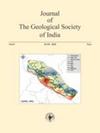Using Edge Detection Techniques on Aeromagnetic Data to Delineate Structures Controlling Orogenic Gold Deposits in the Sefwi Greenstone Belt, Ghana
IF 1.2
4区 地球科学
Q3 GEOSCIENCES, MULTIDISCIPLINARY
引用次数: 0
Abstract
The orogenic-style gold deposits in the Sefwi greenstone belt are associated with quartz veins and occur along shear zones. Edge detection techniques (i.e., analytic signal, vertical, and tilt derivatives) were employed to delineate regional planar fabrics (e.g., shear zones, faults) using aeromagnetic data. The enhancing techniques aided the delineation of NE-SW striking lineaments associated with the Kenyase-Yamfo, Hwidiem, Ketesso, Bibiani, and Afema shear zones in the study area. These shear zones are within the Sefwi belt and at the contact zones between the belt and the adjacent metamorphosed volcano-sedimentary rocks of the Sunyani-Comoé and Kumasi-Afema basins. Low-displacement N-S to NNE-SSW trends which are oblique to the NE-SW shear zones, were also delineated. The local bend and offset along the NE-SW striking faults created by the cross-cutting N-S to NNE-SSW faults serve as favourable trap zones to focus fluids migrating along these shear zones. Fry analysis of known orogenic gold occurrences in the study areas shows that the NE-SW lineaments, with an azimuth of 40°-50°, are predominant in controlling the distribution of deposits. There is also a significant structural control in the N-S to NNE-SSW direction with azimuths 0°-10° and 10°-20°.利用航磁数据的边缘检测技术划分加纳塞夫维绿岩带控制造山型金矿床的构造
塞夫维绿岩带的造山运动型金矿床与石英脉有关,并沿剪切带出现。采用边缘检测技术(即分析信号、垂直和倾斜导数),利用航磁数据划分区域平面构造(如剪切带、断层)。增强技术有助于划定与研究区 Kenyase-Yamfo、Hwidiem、Ketesso、Bibiani 和 Afema 剪切带相关的东北-西南走向线状构造。这些剪切带位于塞夫维带内,以及塞夫维带与邻近的苏亚尼-科莫埃盆地和库马西-阿费马盆地变质火山沉积岩的接触带。此外,还划定了与东北-西南剪切带相斜的低位移 N-S 至 NNE-SSW 走向。横切的 N-S 至 NNE-SSW 断层造成东北-西南走向断层的局部弯曲和偏移,成为有利的捕集区,使流体沿着这些剪切带迁移。对研究区域内已知成因金矿的分析表明,方位角在 40°-50° 之间的东北-西南走向线状构造是控制矿床分布的主要因素。此外,方位角为 0°-10° 和 10°-20° 的 N-S 至 NNE-SSW 方向也有重要的构造控制。
本文章由计算机程序翻译,如有差异,请以英文原文为准。
求助全文
约1分钟内获得全文
求助全文
来源期刊
CiteScore
2.20
自引率
7.70%
发文量
233
审稿时长
6 months
期刊介绍:
The Journal aims to promote the cause of advanced study and research in all branches of geology connected with India, and to disseminate the findings of geological research in India through the publication.

 求助内容:
求助内容: 应助结果提醒方式:
应助结果提醒方式:


